Holiday season is round the corner. For advertisers using Google Shopping campaigns, this is the peak time when they can reap benefits from their PPC activities. So which areas should you drive your focus on, what were the trends during last year’s holiday season, Tracy Carmen and Amanda Melvin unearths some of the key findings and how you can stay ahead of competition with Google Shopping Campaigns.
You can view the video of this session here.
Here is the transcript of the video.
Transcript:
Tracy: Let me introduce myself. I’m Tracy Carmen, I’m on the Americans Shopping Team, and I’m joined by…
Amanda: Hey guys, I’m Amanda Melvin. I’m a Retail Account Manager in Canada.
Tracy: Great. So today, we’re going to be focused on three different things. So talking about some Holiday Insights to prepare you for shopping 2016. Also what you can do to prep for the season in terms of Housekeeping and Merchant Centre in your campaigns and your bidding. And then also what you should do during the holiday season to make sure that you capture all the awesome opportunity we have this year.
So, diving right in, the holiday landscape is really changing for shopping and we’ll take a look. In 2013 what we saw was, the vast majority of shoppers, when they were doing shopping and research, they were looking in-store versus only 46% were looking at a digital device, at a computer or desktop or mobile device.
As we moved towards 2014, we saw it was 50-50, where for the purposes of shopping and researching during the holidays, people were using both in-store foot traffic and digital devices. As of last year, it really changed. For the first time we saw most people using a digital device to do their shopping and their research, and less people going in-store. So we know that 2016 is really the year of digital dominate holiday shopping, which makes it critical for you to have that focus on shopping campaigns this year.
The other piece that we saw was 73% of holiday purchases used digital at some point in their path to purchase last year. And that number is actually higher in Canada at 78% which lets you know that there’s significant impact on your holiday revenue in terms of your digital campaigns.
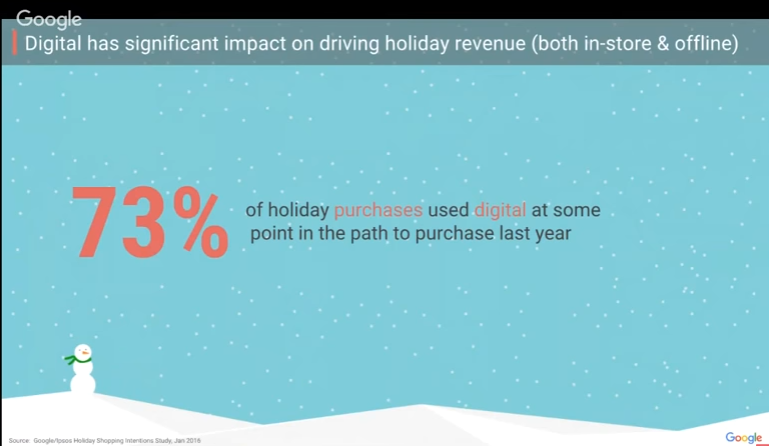
Historically, we see shopping traffic increase every year. Last holiday, it was up 55% versus 2014, and lot of that increase came from mobile devices. So, it was up a 116% year over year versus only 12% of traffic increase from computer or tablet. What that says to us, and why that’s important to you, is that this is the year of mobile. If you really want to capture the increasing holiday demand, it has to be with a mobile-first perspective.
The other piece to think about, and especially for you retailers that maybe don’t have a strong brand presence or feel like you don’t have a strong brand affinity with your consumers, there’s been a huge shift in the last nine years. In 2007, 47% of Americans said that they could identify a favourite retailer or, you know, a favourite department store that’s their ‘Go-To’ to go to and make purchases. In 2015, that number was only 28%. So we’re seeing a 40% decline in people who have this brand affinity towards their favourite retailer.
And for this holiday season, the other piece is one in two holiday shoppers, they’re open to go to a new retailer. This is important for both big brands that previously got to be the favourite retailer, and for new brands that are trying to grab those incremental customers; these holiday shoppers are up for grabs; don’t take it for granted that either you can’t get those shoppers or if you’re a big brand, you’re automatically going to get them. You have to be aggressive and competitive this holiday season to capture that traffic.
In terms of…, we’ve said this before, and we’ll say it again with some data behind it, we know mobile is transforming the holidays. Last year we saw 36% of Black Friday online sales on a mobile device. This isn’t…we’re not talking about research; we’re talking about actual purchases on Black Friday. Same thing with Cyber Monday, we saw 28% of online purchases coming from a mobile device.
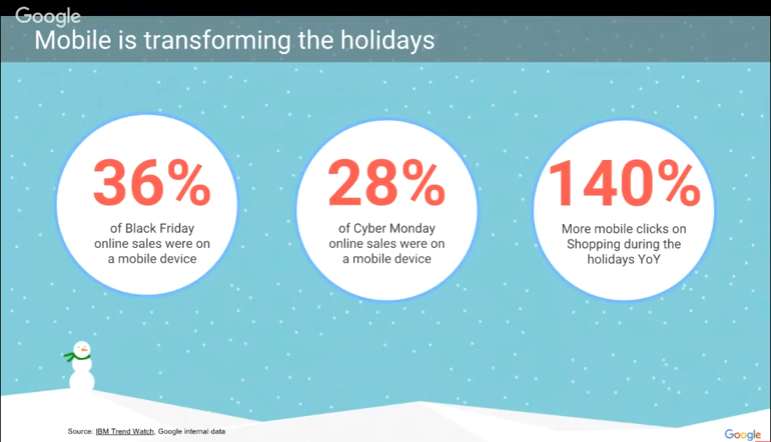
And year over year last year, a 140% were more mobile clicks and shopping during the holidays. We’re expecting that number to continue to increase. And the other thing, if you want to compare, well, gosh, Black Friday, may be people are more likely to purchase on a mobile device. Further, the rest of the year, we’re seeing 30% of purchases still happening on mobile devices.
So it’s critical that you [both] have a friendly mobile experience for people to purchase, but that you’re available for them to make that purchase if the mobile device is the device that they choose to interact with you on. And this gives you an idea of the MasterCard 2016 retail sales focus. This is US-focussed, but we’ll see a lot of the holidays are shared with our Canadians friends as well. Gives you a good idea to look at what are the dates that are online sales, what are the dates that are in-store sales.
Just because you don’t have a store doesn’t mean that you shouldn’t be focusing on some of these days as well, but think about these when you’re looking at your budgeting and bidding strategies. This is really critical and I hear this a lot from merchants, that they really focus on a Black Friday and Cyber Monday and we know that those conversion rates really increase for those days, and then they would hold back right after.
And what we found last year, in November and December, those conversion rates lasted much longer before and after Black Friday and Cyber Monday. So the merchants that pull back early were telling me, “Gosh, we really missed out on a lot of incremental conversions because we didn’t keep our budgets uncapped and we pulled back too fast when there was a lot more customers to take advantage of. “
So now we’re going to move over to Holiday Preparation. And in terms of what we’re going to be looking at, we are looking at Merchant Centre, Campaigns and Bidding. So moving into Merchant Centre, I’ll admit this is the least glamorous part of holiday. No one likes to talk about Data Quality and Feeds, but it’s a crucial part to your system and it’s frankly the foundation of your successful holiday. So we’ll start there and then get to the more fun bits.
Starting with Data Quality, there’s lots of different aspects of Data Quality, but specifically we’ll be seeing holiday season are these three pieces around price and availability mismatch, crawler issues, and then tax and shipping. So in terms of price and availability mismatch, why do we have that? “Why is Google disapproving products when my feed doesn’t match my landing page?”
It’s not because we enjoy disapproving products, are enforcing our policy. We want to make sure that our consumers have a good experience. We want to make sure that when they see an ad that has your brand attached to it, when they get to the landing page, they get what they saw on Google. And that’s really the philosophy behind why we want that fresh price and that fresh data availability information. We’ll talk about a solution on how you can get our special data during the holiday season.
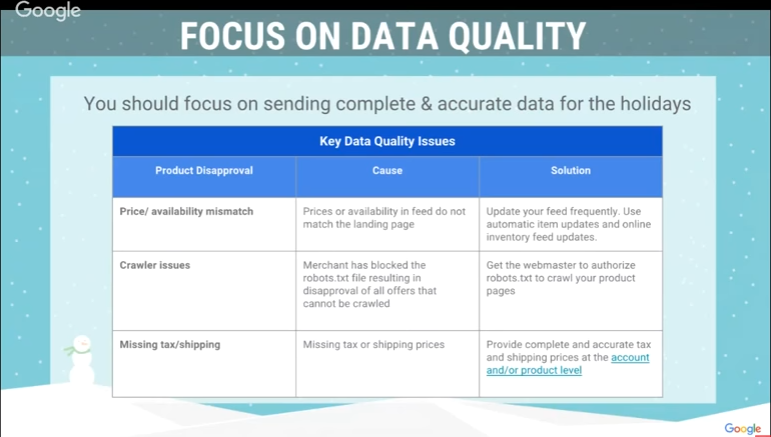
The other piece we hear about is crawler issues. So make sure before your tech teams go into code phase for the year, that you’re not blocking any of our crawlers with a robot.txt file. That could actually also make your products be disapproved if we’re not able to crawl them – those images or those price or availability – we can’t let those items be approved. The other piece with crawling issues as well is that if you have new products for this holiday season, make sure to upload them to your feed.
Even if you put them as “Out of Stock,” we want to make sure that we have enough time to crawl them. If you upload them on Black Friday, we can’t guarantee that we’ll crawl them fast enough for them to show. So if they’re really important to you, make sure that they’re there in advance. The final piece is around tax and shipping. Just like price and availability, we want to have accurate data so our consumers can make the right choice when making a purchase.
So be sure to give us the freshest data from that perspective as well. In terms of giving us fresh price and availability, we do have a new feed that you can do. It’s a complementary feed to your regular merchant’s review called a ‘Product Inventory Update Feed’, and basically what this is is a supplemental feed for products that might have frequent price or availability changes, especially on Black Friday or Cyber Monday. You can upload those products with their new prices or availability, and we’ll be able to process that a whole lot faster than sending us the full feed.
The other piece, and it seems kind of silly, but very important: Make sure you have the right contact in merchant centre. This is where we’ll give you notice if you do happen to get a warning in your account due to a policy or data quality issue. If we don’t have the right person, then you’re not going to be able to get those warnings, and unfortunately we can’t make exceptions because we didn’t have the right contacts to our policies. So make sure that’s updated today.
Amanda: I can’t stress this enough, having an e-mail distribution list as the contact is such a good idea, because so many people go on holiday during this, like pivotal Christmas season, so by having a list where all of the, sort of, people who might be on call or supporting your shopping and online campaigns, really make sure that no one drops the ball, no one’s off on a beach, getting panicked phone calls in the middle of their vacation.
Tracy: Exactly. The other piece that you can consider doing is automatic item updates. This is something more in tech side where they can put a schema.org microdata on your site and we would be able to update your price and availability information automatically. This is not a substitute for giving us good data in your feed, but it’s a good supplemental piece that if you can get it into place before the holidays, it gives you one less thing to worry about. Great. Now I’m turning it over to Amanda to talk about preparing for seasonal events.
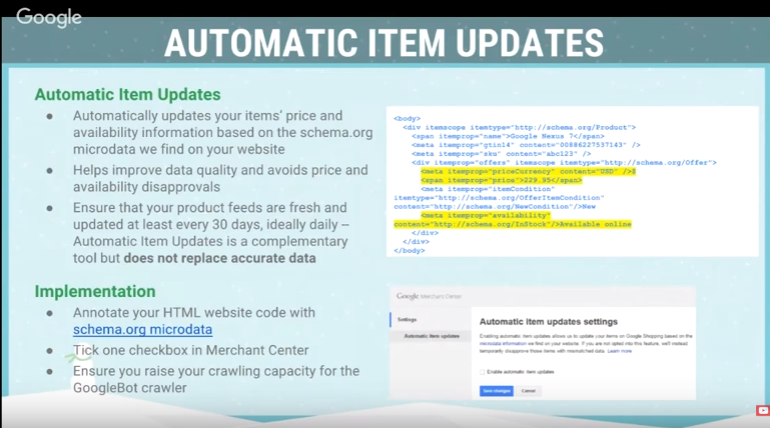
Amanda: So there is like couple of options here in terms of how you can prepare for seasonal promotions like flash sales, or sales leading up to Black Friday and Cyber Monday. And there’s an opportunity to create specific promotions for either all of your products, so this wouldn’t require any change in your feed, or for some of your items, which would require specific updates within your feed. And this policy review to the changes you made during to your feed would only actually happen on Monday to Friday in the business week, and the SKU validation review would occur when the promotion becomes active onsite.
So if you’re uploading in advance, that might take a little bit longer to process. To set this up, you can use the sale price attribute within your feed for the new price, or you can use the sale price effective date for the time and date at which the price change will occur. And you can see there’s a lot more information on this available at the Help centre. As we move into holiday preparation, it’s really important to set yourself up for success by looking at your campaigns. Now, we have a couple of campaign structure recommendations as well as bid recommendations.
When we look at campaigns, when we take a step back, the first thing you really need to think about is what are the product or the product strategies that your organization has decided to approach this holiday season with? Are there specific product lines or departments that have specific budgets in something that’s more important or you know, needs to move off the shelves faster? Or potentially it’s just….they are a higher profit margin, and additionally, are they seasonal products which, you know, if you don’t get rid of your Christmas trees by Christmas, you’re not going to have so much fun selling them in January.
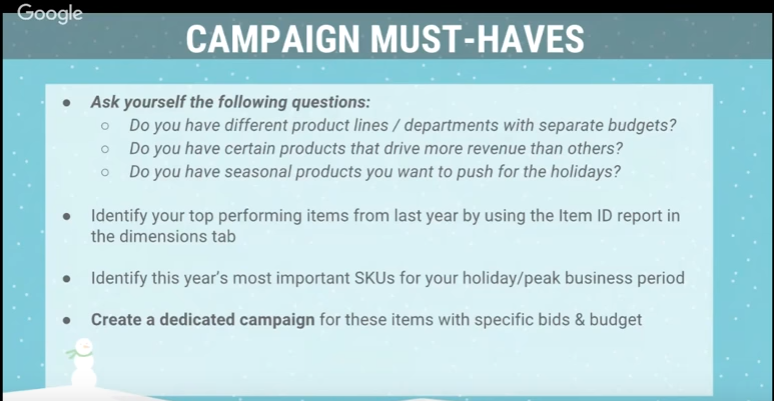
So we recommend you think about this when you’re coming up with your structure. Often, you know, there are different structures for different organizations. And one of the things we really recommend is splitting out a specific campaign at the Item ID level, and you can just also highlight those top-performing products. Now, if you were in the shopping market last year, you can do this by looking at your top-performing items from last year by using the Item ID report in your “Dimensions” tab.
The other opportunity is to just talk to your sales teams, talk to the inventory management people, find out what your most important SKUs are this holiday season and set campaigns out for those SKUs specifically, and then you can set specific bids and budgets against that campaign. And also know you should set that campaign priority to “High” so that that campaign serves first above everything else in your shopping campaigns.
Tracy: And make sure to watch the budget on that campaign since this has your most important items;
you want to make sure that budget stays uncapped and you don’t miss any opportunities in the holiday season.
Amanda: This past year there’s been some great changes to the front-end in AdWords that enabled you to get that much more information right in your campaigns. So one of the things, if you’ve got Item Ids, a campaign including Item IDs is you might be able to see the products status of those IDs and if anything is disapproved, then you’ll be able to troubleshoot it in merchant centre but you’d see the flag in AdWords, which is really great because it provides that real time information to people who are both in marketing because we know sometimes the marketing team and the tech team don’t always [sync] with the same person.
So the last thing, and I really can’t stress this one enough is, it’s really important to create this catch-all campaign, so make sure no opportunity is lost during the holidays. So, what a catch-all campaign is, it looks at all the products you offer countywide, you know, and you would set this up as a low priority campaign, and you would usually set this up to have low bids, and this would target everything you have in your feed that’s available for sale online.
Now, in my two years working on retail in Canada, I’ve seen that these campaigns usually perform within the top three of shopping campaigns all holiday season. It’s extremely efficient, and it makes sure that you’re really showing up against everything a potential shopper’s looking for. Okay, next we move into bidding. As we look into bidding, you know the biggest thing this year that we’ve been recommending to our clients is to take advantage of Enhanced CPC. Enhanced CPC is this amazing automated bidding solution that looks at creative level data to determine who’s the most likely to convert. So for shopping, this is a really natural fit.
You can also review your 2015 conversion rates for guidance on what you can expect moving into the 2016 year. And as conversion rates and queries are going up, you should be using competitive bids to increase your qualified traffic. Now the big thing here with Enhanced CPC is it will only adjust your bid up or down by 30%, so you need to start with a competitive bid in this auction to make sure that, you know, the automated bidding solution is given a platform by which to perform for you.
Tracy: And the big thing on ECPC is, it is the only automated solution that bids at the query level, so there’s no other third party solutions or any of our internal Google solutions that can actually make these changes at the auction level, so if you want that competitive edge, have those competitive base bids and use this as another tool to continue to keep up with the seasonality.
Amanda: So again, as you can see here, we have a Christmas jumper example that we borrowed from my friends in the UK because we just couldn’t get over how fun this Christmas jumper looks. And as you can see, without a bid adjustment, you know, you would have your standard bid across the board, but with your bid adjustment, you can inflate your bid up to, you know, 78 times or more, to get, capture the most high-converting customers.
The next thing we want to talk to you about is remarketing. Remarketing for shopping is a really strong product that lets you serve your shopping ads to people who’ve been on your site historically and who are even more likely to convert statistically. So most retailers have a 30-day cookie window for Remarketing Lists for Search Ads, and that works for them all year round; it’s a very good tactic.
But when you think about it, what that means is, people who’ve been visiting your site in October aren’t actually going to be on your Lists by the time Black Friday rolls around in November. So, you could consider moving your 30-day lists to a 90-day list during this holiday season, and what this does is it’ll provide a 9% more click coverage and a 15% more conversion coverage. So it means your List Search is that much more robust as you enter the holiday season.
Tracy: And don’t forget to discount those repeat purchasers. I myself am like that; I’ll forget to buy something for one of my son’s multitude of teachers, and I’ll go back, I’ll see an ad and I’ll remember, “Oh gosh, I bought something from Hallmark. I’ll go back and make that purchase again.” So just because they purchased from you one time doesn’t mean that they can’t have incremental revenue for you throughout the holiday season.
Amanda: The other thing to think about is just how, what your approach to list segmentation is, you know; adding in All Visitors List is a good start but certainly not the recommended approach. We’d actually recommend setting up your lists across the full purchase funnel, so start with Home Page viewers, move to Category Page viewers, Product Pick and What Offer Page viewers, Cart Abandoners and then finally Cost Converters.
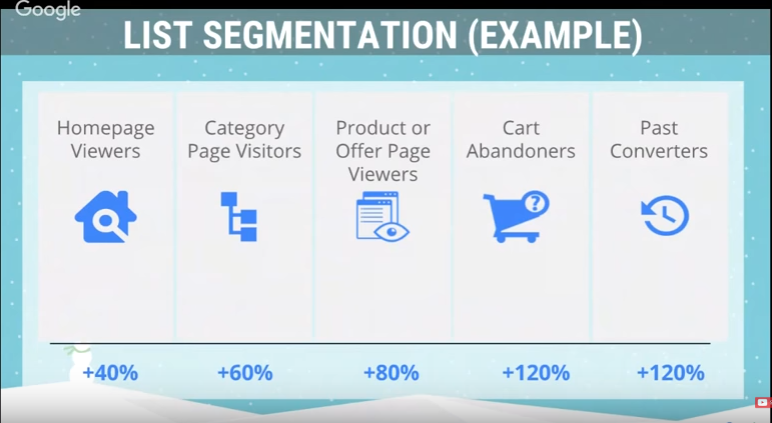
Now, each of these lists should be added to all of your campaigns, but it’s not valuable unless you’re bidding for your list. So often we find advertisers will set this up, and do all of this back end like work to put in their campaigns, and then they forget to address the bids, and at that point, you’re not actually using that extra data that these systems are providing you to say, “Hey, these people are more valuable.”
And typically, as you’ll see from the bid recommendations that we’ve listed across the bottom, you’ll find that people who’ve purchased historically or abandoned cart are more valuable just at a revenue perspective and a potential conversion perspective than people who’ve just visited your Home Page because they’re that much further down the funnel. But you should set this up, watch and then optimize, because it’ll be different for every advertiser.
Tracy: Great. So now we’re going to move from… this is, we’ve done our prep for the holiday season already to get right in, what do we focus on during the holiday season? We’re going to talk about Merchant Centre and Feeds again, Bids and Budgets and then also Local Inventory Ads for those of you who have some brick and mortar stores that are using LIAs.
So starting off with Merchant Centre, …due diligence, you’ve got good feeds, you’re giving us fresh data; make sure that we are still continuing to avoid suspension. So you can use the Merchant Centre Diagnostics tab to look to see if anything is happening in terms of lot of products being disapproved, perhaps we’re not able to crawler you site for some reason. Use that graph as we see highlighted here to see what your feed health is and to know that your products are running as you would expect them to.
This is our big news for this holiday season. We understand that account disapprovals are painful; they really detract from your ability to grow revenue in the holiday season and focus on the things that you’d like to do like gaining new customers. No one likes to deal with account suspensions especially in Q4. We’ve heard this loud and clear, and so we’ve moved this year for many of our top policies from Account Level Disapprovals to what we call Pre-emptive Item Level Disapprovals.
What does that mean? So, once it’s implemented for a certain policy, there’s no account suspension issued any longer; it moves to this Pre-emptive Item Disapproval. And as of now, we’ve launched that for images, and for price. And those are two of the big warnings that we typically see for merchants. You’ll still receive a warning, so if we do find that there are products that have [inaudible 19:41] image or a price issue, we’ll still send you a warning with an exhaustive list of all the products that are affected; you’ll still get 20 days to address those. If you don’t fix those products, that’s when the Pre-emptive Item Level Disapproval kicks in.
And what that means is versus us taking down your entire account for only a handful of bad apples, we’ll only disapprove the items that we think have a high likelihood of violating our policies. So this means there’s less troubleshooting on your side because we’re giving you a list of products that are affected and that you’ll be… The important thing, though, data quality does remain important. You should still continue to give us the right information to be able to avoid some of those Pre-emptive Item Level Disapprovals, but hopefully it will stop your focus from having to be on account suspension fire drills and more about growing your customers.
So now let’s talk about Bids and Budgets during the holiday season. You’ve already done a look back on what your highest performing products were before, you’ve turned on ECPC, what do you do now? Here’s the big thing: Make sure that you’re budgeting to keep your digital store open. When you’re capped by budget, it’s the same thing as a physical store, shutting their doors once a week. You don’t want to be that store in Q4. So what do you need to look at? What are the things that are important to know?
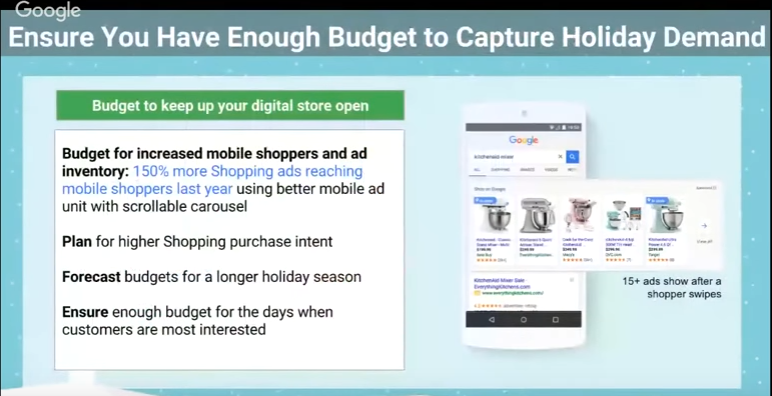
The big thing this year, you know, we saw a lot of those statistics, that more and more of the consumers who go to Google are looking from a mobile device. We realized that and in the past year we’ve expanded our mobile unit and also added more slots to accommodate what our customers were asking from us. What that means to you is there’s more inventory. As of last year, a 150% more shopping ads are reaching mobile shoppers; it means you should budget to take advantage of that inventory. You don’t want to be budget capped and then miss out on some of this great opportunity with our new scrollable carousel.
The other point to do as well is you need to plan for higher shopping purchase intent and throughout the holiday season. We hear this again and again, there’s a lot stores that they’re starting their Black Friday sales the first week of November. And so, we have to be aware that the holiday season has elongated, so we must forecast your budget to be able to take advantage of that entire time. Now it’s not just Black Friday and Cyber Monday where you’re able to get most of your sales; there’s a lot more opportunity there.
So make sure you have enough budget for all the dates when customers are interested. And you can even look back in your own account and see when you had the highest conversion rates last year, and plan on making sure that you’re available this year around those times as well.
Amanda: And just to add on to this, when you think about what people are doing on their mobile phones, we know a lot of them are making purchases, but I know when we work with account teams, often we get the feedback, you know, mobile’s just not as valuable, it doesn’t convert as much, but you should be taking back to your teams that just as often if someone does convert on their mobile phone, people might be standing in store and looking at your product and checking out the different other products that are available at other retailers, and seeing what the prices are, seeing if the variety or the colours are any different, so by not showing up in that mobile auction, you might actually be losing customers in store. And so you can pick up a mobile a little bit differently as really being that, like, additional sales support in-store as well as being a driver of conversions online.
Tracy: Absolutely. You just want to be where your customers are, and if they want to be on a mobile device, then make sure that you’re there for them. So how do you look at ad bidding? There are still two things that we really want to focus on in bidding this holiday season. First, bid competitively; as we mentioned, we know that there’s higher conversion rates in shopping, sometimes up to a 60% increase in 2015 that we saw in the US during the holiday peak. So make sure that you’re reviewing your bids regularly, not just on computer but also on mobile devices to Amanda’s point.
It’s really important to stay on top of it; this auction is very competitive during the holiday season and you want to make sure that you’re viewing your bids especially during those increasing conversion rate days as I mentioned. Look back on last year; see when your conversion rates increased. Sometimes you might even be surprised on what those high days were for you. Make sure you’re bidding competitively around those days.
The other side is, really make sure that you’re standing in the top results for your top products. What does that mean? So what we found is, we expanded our mobile carousel and we’ve expanded our mobile unit as our customers’ show that they want to interact on a mobile device, that for shopping ads in those top two results in the mobile carousel, they see up to three times a CTR, three times engagement from shoppers. That’s huge. Let’s say if we’re bidding on a text ad, we talk a lot about bidding to those first three positions; same thing goes with mobile on our shopping ads.
Now I know the first thing people are thinking right now is, “Goodness Tracy, you don’t have a position report for shopping, so how do we know how to bid to those top slots?” We have a solution for you. So there is two actions that we’ll talk about. One, use Auction Insights in the AdWords front-end to monitor who your top competitors are. You can look at the Overlap Rate and you can look at Outranking Share and that’s how you can even see if there’s going to be some new players in the market in your category or if may be some players are going out, there’s an opportunity to take advantage of their share. I highly recommend looking at that at least once a week during the holiday season to get a lay of the land.
The other piece is using Click Share to measure how you’re performing on your top categories. So let’s talk a little bit more about Click Share. As I mentioned, we don’t have the position reporting for shopping ads. But we can really use this Click Share metric that you see in this screenshot you can see in AdWords as a proxy proposition. Click Share’s a really good indicator of performance opportunity because we know with Click Share we’re driving actual traffic. And the more Click Share is increased….excuse me, you can increase Click Share by improving your position. So as we see Click Share increasing, we know that you’re appearing in those higher position slots. But how do we influence Click Shares? So how can we make sure that we are increasing that Click Share number? Bids.
So bids are the highest factor, which makes a lot of sense. For your most important products, you want to make sure that you’re continuously increasing that Click Share. Even if you are increasing that Click Share week over week, continue to be very aggressive to make sure that you don’t lose any of that to some of your competitors. The other piece is Feeds, so Feed Quality. Make sure you’re giving us the right prices, not to be the debtors again, the right prices, the right images, all that stuff can impact your Click Through Rate and that really impacts Click Share as well.
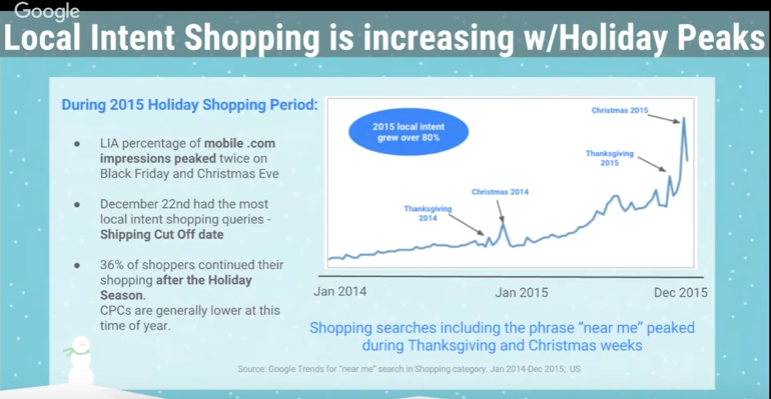
So just as I mentioned, focusing on this Auction Insights once a week, once you get a lay of the land about who’s the competitors… Also look at that Click Share every week or even multiple times during Black Friday and Cyber Week to make sure that you’re taking advantage of the increasing shopping ads that we have and the increasing opportunity we have this year. So the other piece we wanted to talk briefly about was Local Inventory Ads. I’m not suggesting that if you are already doing Local Inventory Ads or if you don’t have a brick and mortar store to focus on this, but for those of you who already have Local Inventory Ads set up, we want to let you know local intent for shopping increases as the holiday peaks increase.
So we see that the Local Inventory Ad percentage on mobile impressions peaked twice, both on Black Friday and on Christmas Eve, which makes a lot of sense. It really lines up with when the last shipping day is, the shipping cut off, will we expect to see a peak afterwards as people realize they ran out of time, it won’t ship fast enough, they have to go in store. So for those of you who have Local Inventory Ads make sure that your CPCs are where they need to be to take advantage of these peaks.
Amanda: If you don’t have Local Inventory Ads, if you’re a Canadian client where it hasn’t launched yet, think about Local Inventory Ads as a proxy for how you could be positioning yourself in mobile, where you see on this [track] there were peaks in local intent, heavy up on mobile on those days just to make sure you guys are present while people continue shopping.
Tracy: Absolutely. So this is a nice checklist for you in terms of what we should be doing the rest of this month versus what you should focus on in November and December. In October, number one, as Amanda stated, let’s make sure that we have the right contact in Merchant Centre. Heaven forbid, if you do get some of those suspension warnings, you want to make sure it goes to the right person who can act on it. Set up those merchant promotions and sales attributes.
Look at your 90-day Remarketing List for Search Ad list, implement that Automatic Item Updates or that Inventory Feed Update that we talked about and create those top products and catch all campaigns that Amanda talked about as well. And in terms of throughout the holiday season, make sure you are monitoring for those suspension warnings and in your Diagnostics tab, monitor the budgets, make sure that your digital store is online the entire day of the holiday season. And bid competitively, really using Click Share and those Auction Insights to make sure that you’re monitoring how competitive you are and you’re taking advantage of the gift that we’ve given you with these new mobile carousel ads.
Amanda: Hey look, we want to say thank you to everyone for dialling in and joining us here today. We’re really happy to have presented this to you. So far we don’t see any questions that have been posted. We’re going to hang out for a little while and if you have questions, feel free to post them and otherwise, thank you for joining. Good luck in holiday and with all of your holiday shopping campaigns. And we’ll talk to you soon.
Tracy: Yeah, happy holidays and happy shopping.
Related Articles:





Stop the wasted ad spend. Get more conversions from the same ad budget.
Our customers save over $16 Million per year on Google and Amazon Ads.